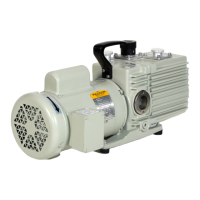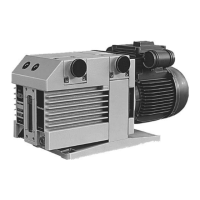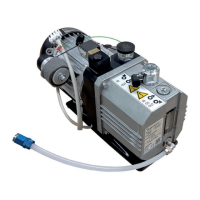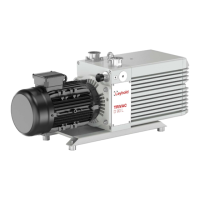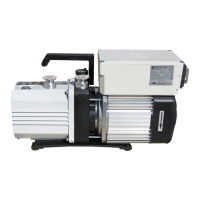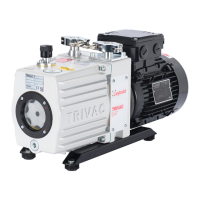F-9 Install the coupling (37)
onto
the module shaft
as
follows
(see
Figures 5-3 and 5-4).
a.
Align the slot in the coupling
with
the key (38) on the shaft.
b. Slide the coupling onto the shaft until
it
rests
against the retainer ring (40).
c.
Screw the coupling setscrew clockwise until
it
is
tight.
F-10 Grab the coupling (37) and
turn
the module shaft
(see
Figure 5-3).
If
the end plates (44/60), pump cylinders
(46/55).
and
center bearing (52)
are
aligned properly, the shaft will turn smoothly.
If
there
is
any binding, adjust
the alignment
as
follows:
a.
Loosen the hexagon nuts (63) on the threaded studs (62) (see Figure 5-6).
NOTE: The D16A and
DBA
pump models have four rather than three nuts and studs.
b.
CAUTION: BEFORE STRIKING THE REAR END PLATE (60), ENSURE THAT THE DISK(61) (see
Figure 5-2)
IS NOT ASSEMBLED TO THE MODULE.
Strike the face
of
the rear end plate (60) a couple
of
times while
cross-tightening
the hexagonal
nuts (63) (see Figure 5-6).
Tighten
these nuts until all are snug.
c.
Grab the coupling (37) and turn the module shaft to see if the shaft turns smoothly (see Figure
5-3).
Many times the act of turning the shaft will bring the module into alignment.
d.
Continue repeating Steps F-10a through F-10c until the shaft turns smoothly and there is
no
bind-
ing.
It
is sometimes necessary to loosen or tighten each hexagon nut several times to eliminate
all
binding. Many times, it is necessary to tighten two of the nuts (63) and loosen the other nut(s)
a bit. However,
all nuts should be tightened to roughly the same torque.
e.
Test the breakaway torque of the shaft. It must be less than 15 in.llbs.
f.
If you cannot eliminate the binding, there must be
an
obstruction inside of the module.
In
this case,
disassemble and inspect the module,
eliminate the obstruction, and then reassemble the module
ensuring that
all parts are installed properly.
F-11
NOTE:
When
the pump
is
not
running, the air inlet tube (69) should
be
open.
When
the pump
is
running, the
centrifugal switch (39) should
pull away from the lever (41) causing the lever
seal
(43)
to
close the air inlet tube
(69)
(see
Figures 5-3
and
5-4).
Ensure
that the anti-suck back mechanism
is
operating correctly
as
follows:
a.
Check
to
see
if
there
is
a
gap
between the lever
seal
(43)
and
the end
of
the air inlet tube (69).
If
there
is
not
a
gap
while the pump
is
at rest,
it
means
that the lever (41)
is
bent, the spring (42)
is
out
of
position,
or
the centrifugal switch (39)
is
malfunctioning. Remedy the problem before
proceeding
(see
Figures 5-3
and
5-4).
b.
Check
if
the anti-suck back mechanism will
close
the air inlet tube (69)
as
follows:
(1)
Push
the split
halves
of
the centrifugal switch (39)
until
they
are
tight
against the cou·
piing (37).
(See
Figure 5-3.)
(2) While keeping the split
halves
of
the switch (39) against the coupling (37), check
if
the
lever
seal
(43)
is
sealing the opening in the air inlet tube (69)
(see
Figure 5-4).
(3)
If
the lever
seal
(43)
is
not
properly sealing the tube (69),
see
Symptom
3h
of
the
troubleshooting chart (Table 6-1)
for
recommended corrective action.
c.
Make
sure
that the air inlet tube (69)
is
pushed back
into
the module until
it
is
seated
firmly.
When
the air
inlet
tube (69)
is
installed properly, the retainer disk (71) fits against the
front
end
plate (44)
(see
Figure 5-4).
F-12
It
is
easiest
to
guide the module
into
alignment with the coupling housing (11) when the coupling housing/motor
assembly
is
in the vertical position
(see
Figure 5-23).
Proceed
as
follows:
a.
Set
the coupling housing/motor assembly back onto its
motor
end
and
secure
the assembly in this
vertical position.
b.
Place
the main housing
seal
(13) onto the coupling housing flange
(see
Figure 5-2).
c.
Keeping the module vertical, guide the module
end
that
has
the coupling (37) down into the
coupling housing
(11
I.
The prongs on the module coupling (37)
fit
into
the mating slots in the
elastic element (36); the elastic element
is
located on the
motor
shaft in the coupling
hOUsing
(11).
Look
through the opening in the bottom
of
the coupling housing (11)
to
align the mating prongs
and
slots properly
(see
Figure 5-23).
d.
Use
the
screws
and
washers
to
attach the module
to
the coupling housing (11)
(see
Figure
5-21.
e.
Return the assembly
to
the horizontal position.
TRIVAC
"An
Manual, Edition L
41
